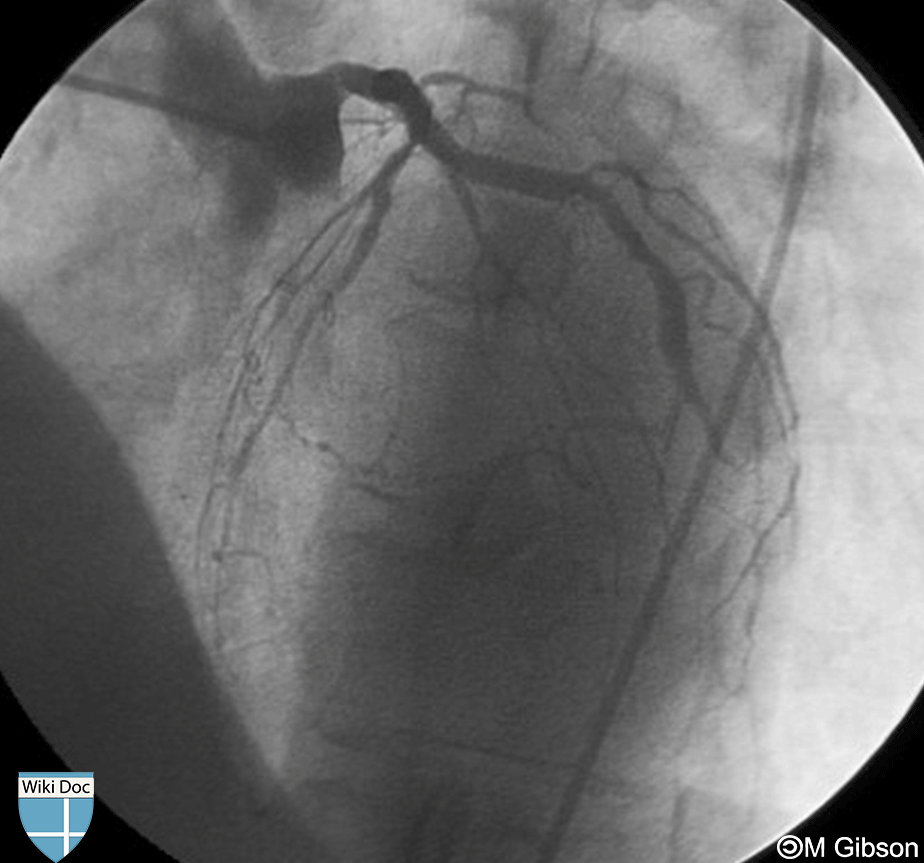Coronary collaterals: Difference between revisions
Rim Halaby (talk | contribs) m (Rim Halaby moved page Coronary angiography collateral artery to Coronary collaterals) |
Rim Halaby (talk | contribs) No edit summary |
||
| Line 5: | Line 5: | ||
Coronary collateral arteries bypass the blockage in the main artery and supply enough oxygenated blood to enable the cardiac tissue to survive and recover. | Coronary collateral arteries bypass the blockage in the main artery and supply enough oxygenated blood to enable the cardiac tissue to survive and recover. | ||
== | ==Classification== | ||
====Complete Collaterals==== | |||
====Partial Collaterals==== | |||
====Myocardial Collaterals==== | |||
==Grading System== | |||
Angiographic assessment of apparent collaterals is useful to quantify the angiogenic response to interventions designed to enhance myocardial perfusion and function in ischemic myocardium.<ref>Fuchs S. Lack of correlation between angiographic grading of collateral and myocardial perfusion and function. Coron Ar Disease 2001; 12: 173-78.</ref> <ref>Abbott JD, Choi EJ, Selzer F, Srinivas VS, Williams DO Impact of Coronary Collaterals on Outcome Following PCI [from the NHLBI Dynamic Registry]. Am J Cardiol. 2005; 96: 676–680.</ref> <ref>Koerselman J, van der Graaf Y, de Jaegere PP, Grobbee DE. Coronary Collaterals an Important and Underexposed Aspect of Coronary Artery Disease. Circulation. 2003; 107: 2507-2511.</ref> Collateral Circulation is assessed visually using the following grading system: | Angiographic assessment of apparent collaterals is useful to quantify the angiogenic response to interventions designed to enhance myocardial perfusion and function in ischemic myocardium.<ref>Fuchs S. Lack of correlation between angiographic grading of collateral and myocardial perfusion and function. Coron Ar Disease 2001; 12: 173-78.</ref> <ref>Abbott JD, Choi EJ, Selzer F, Srinivas VS, Williams DO Impact of Coronary Collaterals on Outcome Following PCI [from the NHLBI Dynamic Registry]. Am J Cardiol. 2005; 96: 676–680.</ref> <ref>Koerselman J, van der Graaf Y, de Jaegere PP, Grobbee DE. Coronary Collaterals an Important and Underexposed Aspect of Coronary Artery Disease. Circulation. 2003; 107: 2507-2511.</ref> Collateral Circulation is assessed visually using the following grading system: | ||
| Line 21: | Line 28: | ||
[[Image:Collaterals-(OM-PDA).gif|300px|Collateral artery between the OM and the PDA]] | [[Image:Collaterals-(OM-PDA).gif|300px|Collateral artery between the OM and the PDA]] | ||
[[Image:Collaterals-(OM-PDA)-static.gif|300px|Collateral artery between the OM and the PDA: Outlined in yellow in the image on the right is the collateral artery.]] | [[Image:Collaterals-(OM-PDA)-static.gif|300px|Collateral artery between the OM and the PDA: Outlined in yellow in the image on the right is the collateral artery.]] | ||
==Additional Examples== | |||
Click '''[[Coronary collaterals case studies|here]]''' for more examples of coronary collaterals. | |||
==References== | ==References== | ||
Revision as of 15:38, 6 September 2013
Editor-In-Chief: C. Michael Gibson, M.S., M.D. [1]; Associate Editor(s)-in-Chief: Hilda Mahmoudi M.D., M.P.H.[2]; Rim Halaby, M.D. [3]
Overview
Coronary collateral arteries bypass the blockage in the main artery and supply enough oxygenated blood to enable the cardiac tissue to survive and recover.
Classification
Complete Collaterals
Partial Collaterals
Myocardial Collaterals
Grading System
Angiographic assessment of apparent collaterals is useful to quantify the angiogenic response to interventions designed to enhance myocardial perfusion and function in ischemic myocardium.[1] [2] [3] Collateral Circulation is assessed visually using the following grading system:
- Grade 0: No collaterals present. Angiography fails to reveal evidence of collateral vessels.
- Grade 1 (or partial): Minimal collaterals present. Evidence of minimal to partial filling of the recipient branch epicardial arteries/infarct region. It is not necessary for one to see the branches connect directly to the major epicardial artery.
- Grade 2 (or complete): Well-developed collaterals. Evidence of collateral circulation with near complete to complete filling of the recipient major epicardial artery/infarct region.
- Grade 3 (myocardial): Filling of the myocardium by collaterals. If the collaterals are not filling any visible arterial branch, but are only participating in the perfusion of the myocardium.
Angiography Examples
Shown below are an animated image and a static image depicting collateral artery between the OM and the PDA. Outlined in yellow in the image on the right is the collateral artery.
Collateral artery between the OM and the PDA

Additional Examples
Click here for more examples of coronary collaterals.
References
- ↑ Fuchs S. Lack of correlation between angiographic grading of collateral and myocardial perfusion and function. Coron Ar Disease 2001; 12: 173-78.
- ↑ Abbott JD, Choi EJ, Selzer F, Srinivas VS, Williams DO Impact of Coronary Collaterals on Outcome Following PCI [from the NHLBI Dynamic Registry]. Am J Cardiol. 2005; 96: 676–680.
- ↑ Koerselman J, van der Graaf Y, de Jaegere PP, Grobbee DE. Coronary Collaterals an Important and Underexposed Aspect of Coronary Artery Disease. Circulation. 2003; 107: 2507-2511.